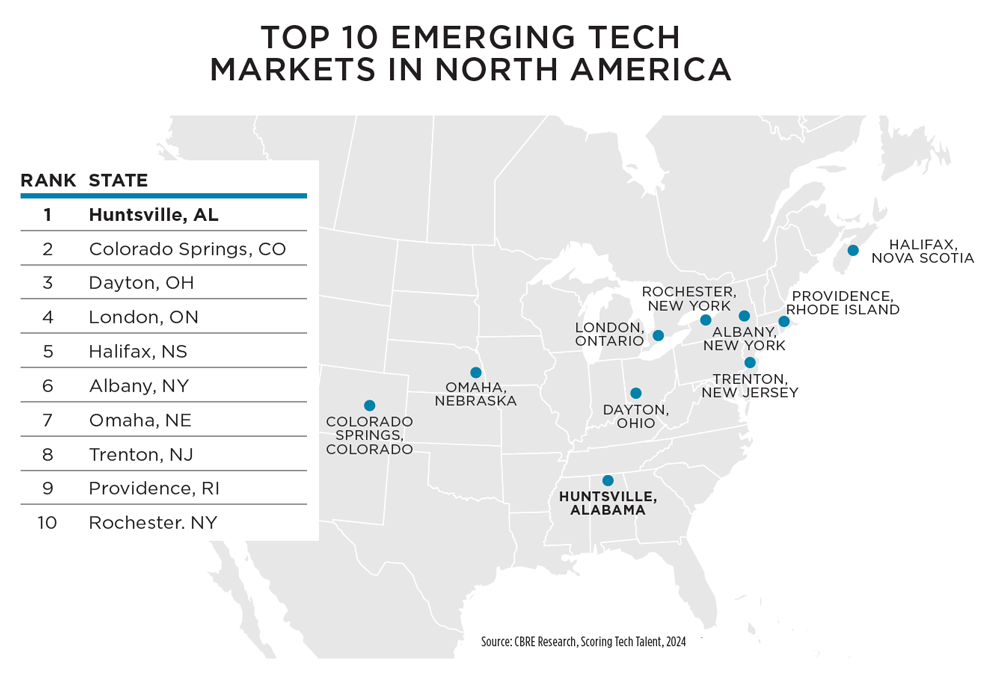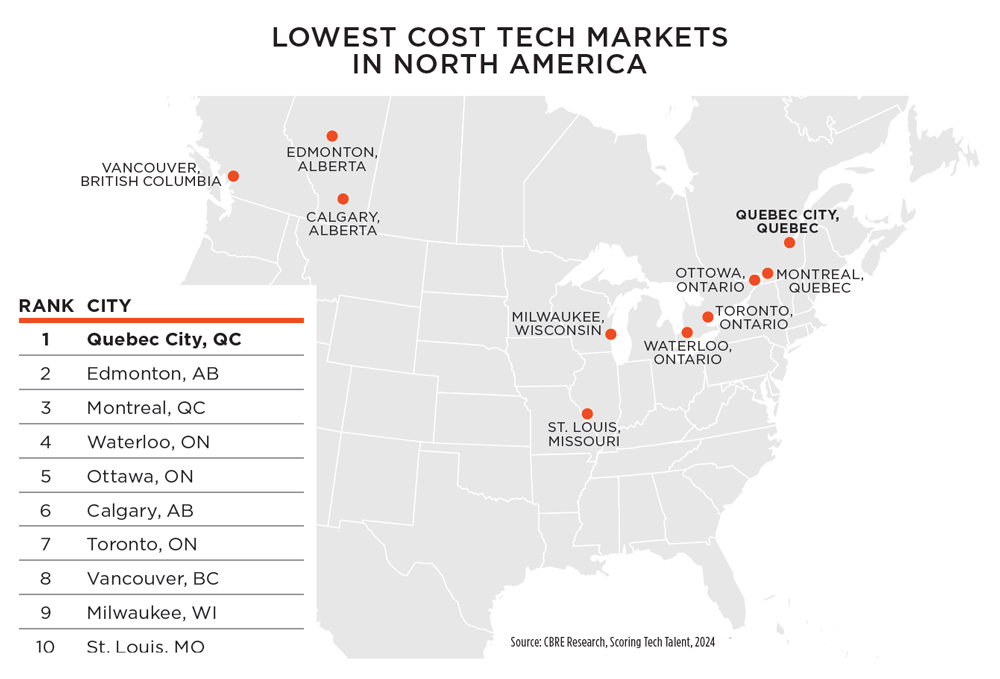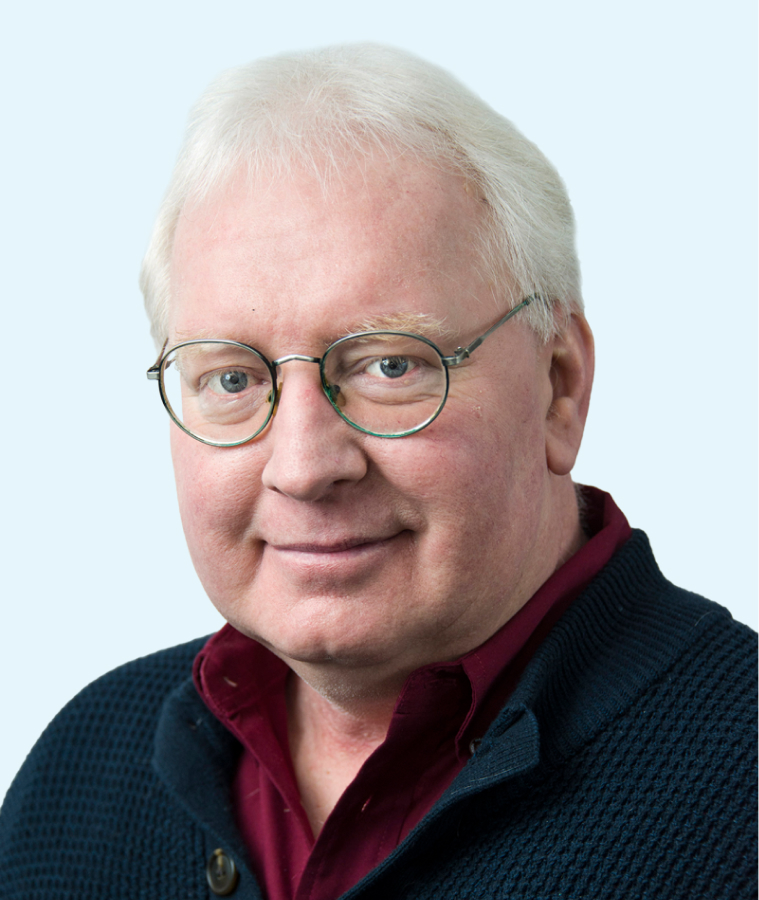Quality of life, cost of living drive young workers to second- and third-tier towns.
Surging demand for AI-specialty tech talent is driving workers and capital investment to established tech hubs in North America while also prompting a flight to quality locations that can be had at lower costs.
CBRE Research released its annual Scoring Tech Talent report in September, and many of the findings were not surprising. For example, the top tech talent markets overall on the continent are, in order, San Francisco, Seattle, metro New York, Toronto and Austin. The next five are Washington, D.C., Boston, Denver, Dallas-Fort Worth and Ottawa.
While tech talent growth slowed overall in North America, the demand for tech workers with specialized skills increased, CBRE said. “U.S. tech talent employment grew by 3.6% overall or 213,000 jobs, while AI-related jobs grew by nearly twice that rate,” the CBRE report stated. “Software developers and programmers, which account for most of these AI roles, accounted for 72% of all new tech talent jobs in 2023. The slowdown in overall tech talent job growth last year (3.6% vs. 7.3% in 2022) allowed non-tech industry employers to increase their share of tech talent hiring.”
Remote working is also causing a shift in geographic diversity of these highly compensated workers, notes the report. “Remote working arrangements have allowed tech talent employers to diversify their workforce both geographically and demographically,” CBRE said. “While most employers have adopted hybrid arrangements of both in-office and remote work, 15% of U.S. tech talent job postings offer fully remote as an option.”

The Orion Amphitheatre is an outdoor, 8,000-seat concert venue in Huntsville, Alabama.
Photo courtesy of Huntsville/Madison County Chamber
This fact, combined with other demographic trends, opens new markets for employers seeking highly coveted tech talent. Along those lines, CBRE cited these markets as up-and-comers in the tech talent scorecard: Huntsville, Alabama, leads the way at No. 1, followed by Colorado Springs, Colorado; Dayton, Ohio; London, Ontario; and Halifax, Nova Scotia. The remainder of the top 10 emerging markets for tech talent in North America are, in order, Albany, New York; Omaha, Nebraska; Trenton, New Jersey; Providence, Rhode Island; and Rochester, New York.

“We know where the top talent is in North America, and we go to them and tell them why they ought to consider a move to Colorado Springs. What we have found is that this is a place where young people want to be.”
— Johnna Reeder Kleymeyer, President & CEO, Colorado Springs Chamber & EDC
We reached out to several of these markets to find out what they are doing to attract, develop and retain tech talent. Here is what they said:
Lucia Cape, senior vice president of economic development, Huntsville/Madison County Chamber, Alabama: “We launched ASmartPlace.com, a brand-new website, to attract site selectors, businesses looking to relocate, and people looking for opportunities in their careers. We are seeing people move into our labor shed every day. External recruiting is a big reason why The Rocket City has become a popular destination for tech talent. We also do a lot of work with our colleges and universities and high schools around career awareness. Driving Possibilities is the Toyota career awareness program that we are using at the local high school level. More than 60% of our students at the University of Alabama-Huntsville are learning in STEM fields — and we retain about 80% of them who go on to work in these fields here after graduation.”

Johnna Reeder Kleymeyer, president and CEO, Colorado Springs Chamber & EDC, Colorado: “We have seen amazing growth in this region since 2010. We have grown at more than double the national average. Most of our growth is in the younger demographic. Over 50% of our population has a degree or a credential. Our built-in secret sauce is having five military installations in the region. Research in aerospace and defense is our strongest cluster. Our top three sectors are aerospace and defense, cybersecurity and technology, and advanced manufacturing. We have over 350 companies with more than 30,000 workers in those sectors. We know where the top talent is in North America, and we go to them and tell them why they ought to consider a move to Colorado Springs. What we have found is that this is a place where young people want to be.”

Jeff Hoagland, president and CEO, Dayton Development Coalition, Ohio: “We have the largest single-site employer in Ohio — Wright-Patterson Air Force Base — with over 38,000 people employed inside the fence. Tens of thousands more are employed outside the fence. With the Air Force Research Lab headquartered here, as well as the National Space Intelligence Center and the Air Force Digital Transformation Office, some of the best intellectual capital in the world is in Dayton. Talent comes from Boston, New York, Washington, D.C., and other places. Find Your Ohio is a talent attraction initiative that we are working on with JobsOhio and Lt. Gov. Jon Husted. Our aim is to bring retiring military personnel back to Ohio, and we are seeing success with that program.”
Heath Mello, president and CEO, Greater Omaha Chamber, Nebraska: “Intern Nebraska is a state program we use to provide financial assistance to businesses that create new internships. That helps grow our tech talent. The Nebraska Tech Collaborative also helps build out our tech workforce. Our University of Nebraska system has been engaged over the years in this effort as well. We have some unique tech infrastructure in Omaha, such as the UN Medical Center and UN Omaha, which created the first-ever AI degree in Nebraska. They just received approval to launch this 4-year degree program.”
Matt Hurlbutt, president and CEO, Greater Rochester Enterprise, New York: “It goes back to our core, which is the fact that we have 18 colleges and universities with 75,000 students and 17,000 graduates a year. We also grab graduates from Buffalo, Syracuse and Cornell. SUNY-Brockport has a cybersecurity program, and Monroe Community College offers an associate’s degree in precision optical technology — the only one of its kind in the U.S. That program supports Corning, Optimax and other large investors in Greater Rochester. Micron, as well, is doing extensive work with Rochester Institute of Technology. In 2025, you will see us continue to leverage our tech corridor initiative and continue to work on semiconductor supply chain technologies to support Micron, Edwards Vacuum and other companies that are growing rapidly in this part of Upstate New York.”

